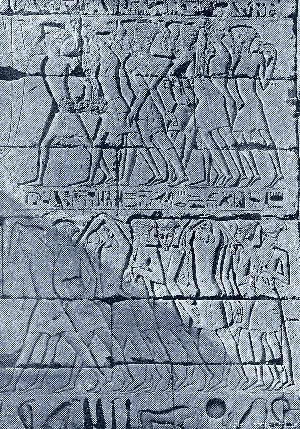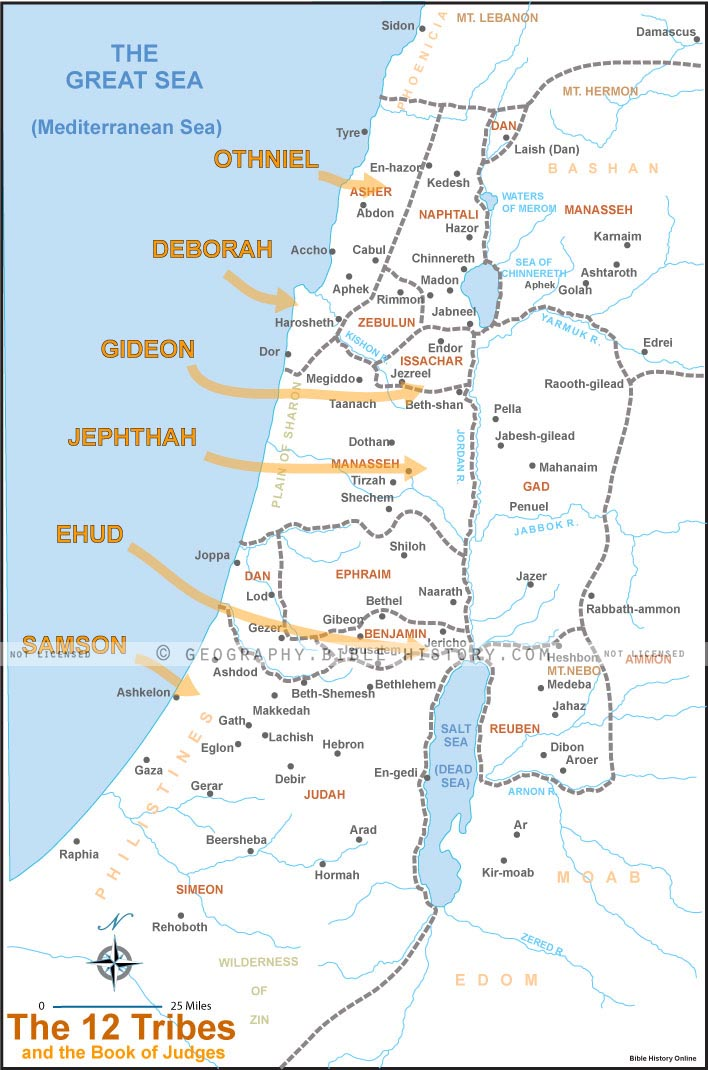Judges
Images and
NotesThe Book of Judges
Judges
4:1 - And the children of Israel again did evil in the sight
of the LORD
Judges
6:6 - And Israel was greatly impoverished because of the
Midianites; and the children of Israel cried unto the LORD.
Judges
6:7 - And it came to pass, when the children of Israel cried
unto the LORD because of the Midianites,
Judges
6:8 - That the LORD sent a prophet unto the children of
Israel.
ARCHAEOLOGY
Philistine Captives
Temple of Ramses III

The ancient Egyptian
temples reveal what the Philistines looked like in the
ancient world. In the sculptured scenes within the
funerary temple of Ramses III at Medinet Habu, near
Thebes in Upper Egypt, is an incredible bas relief
portraying Philistine captives. Pharaoh had hired these
warriors as mercenaries. Rameses III who reigned from
1198-1167 BC saw that the Canaanite area was being
invaded and with the help of the Philistines he
established peace, according to his own record. Later
the Philistines rose to a powerful position in the
region with five powerful cities, they flourished in the
time of Samson and the judges, their supremacy might
have been due to their formal acknowledgment of pharaohs
authority. Within a couple centuries they disappeared
from history.
The Old Testament - A Brief Overview
Bible Survery - Judges
Hebrew Name - Shophtim "Judges or Deliverers"
Greek Name - Krites (Greek form of the Hebrew)
Author - Samuel (According to Tradition)
Date - From 1425 to 1120 BC Approximately
Theme - 7 cycles of idolatry, oppression, repentance, and
deliverance during the first 300 years in the land of Canaan
Types and Shadows - In Judges Jesus is the great judge and
deliverer of His people
Summary of The Book of Judges
In the book of Judges we can see the first 300 years of the
history of Israel, from the time of the death of Joshua to the
time of Samuel the last of the Judges. All of the events
mentioned in the book of Judges are not meant to be given in a
strict chronological order and it is impossible to determine
exact dates. Everything that took place happened really on a
local level in the land of Israel and not necessarily on a
national level. The first two chapters deal with the death of
Joshua and after his death and the generation surrounding him,
"there arose another generation after them, who did not know the
Lord or the work which he had done for Israel" (Judges 2:10).
This generation of Israelites, and every generation after
that during this time period fell into idolatry, they forgot the
commands of God and there is a severe decline morally and
spiritually. As each generation unfolded idolatry would prevail,
a foreign invasion would take place and oppress the people of
Israel in that local area, they would cry out to God for help,
and God would send a deliverer. This cycle happened seven times
in the book of Judges and speak clearly about the cycle of sin
and its consequences, as well as God's love and willingness to
send help when his people cry out to him.
Quick Reference Map

Map of the Judges and the Twelve
Tribes of Israel
(Click to Enlarge)
The book of Judges records six such major invasions:
Outline of the Book of Judges
The first was the Mesopotamian invasion from the northeast (Judges 3:8-11) from which
Othniel delivered his people.
The second was by the Moabites and came from the southeast (Judges 3:12-20). Israel was
delivered from the Moabites by Ehud, the left handed assassin of the Moabite
king, Eglon.
The third invasion came under the Canaanite leaders Jabin and Sisera (Judges 4,
5). Israel was delivered from the Canaanites by Deborah, the only woman judge of
which there is any record. It is interesting to note that Sisera himself was
killed by a woman, Jael, the wife of Heber the Kenite.
The Midianite invasion from the southeast (Judges 6-9) lasted seven years and was
ended under the bold leadership of Gideon.
The foolish vow of Jephthah, which cost him the life of his daughter, came after
he delivered Israel from the fifth invasion, that by the Ammonites from the east
(Judges 10:6-11:40).
The sixth invasion was by the Philistines, from the southwest, and was
apparently something of a recurrent nature rather than one particular campaign.
During a period of at least 200 years, Israel was delivered from the Philistines
by Shamgar, Samson, Samuel, Saul, and David.
The major social problem stemmed from the recurrent failure of the Israelites to
drive the Canaanites out of the land, a direct violation of God's commandment.
The Israelites then intermarried with the Canaanites, adopting many of their
customs. This assimilation of Canaanite culture promoted the growth of idolatry
which constituted the religious problem of the people.
The three most prominent deities of Canaanite worship were Baal, Asherah, and
Dagon.
Baal was usually represented by a stone pillar and was a god of fertility,
usually worshipped in the groves. At various times Baal-worship included
fornication (Jeremiah 7:9 ), self-mutilation (1 Kings 18:28), and human sacrifice
(Jeremiah 19:5). Baal is the deity most often mentioned in the Old Testament as
being a snare for the people of God.
The symbol of Asherah was a wooden post set up in the "high places" of
idolatrous worship. The Phoenician goddess of procreation and love, she was the
chief female deity and is often mentioned in connection with Baal.
Dagon was a Philistine deity having the body of a fish with human hands and a
human face. It was a temple of Dagon which Samson pulled down in his final act
of strength.
There is seen in the book of Judges a consistent pattern�Israel is oppressed by
a foreign power; the people cry to God and he raises up a judge to deliver them
from their predicament; after peace is established the people become complacent
and relapse into idolatry.
The judges, although chosen by God, to lead His people, were not always men of
ideal character, yet they fulfilled God's purposes in delivering Israel. They
served in a multiple role as judicial, military, and spiritual leaders. The
period of the judges may be said to extend through the life of the last judge,
Samuel, whose death is recorded
in 1 Samuel 25.
Quick Reference Maps -
Judges
The Twelve Tribes and the Judges
Hazor
Jezreel
Mizpeh
Zorah
The Danites
Gibeah
Jabesh Gilead

Judges Resources
The
Judges
More About the Book of Judges
Judges in the
Picture Study Bible
Timeline of the Ancient
World
Back to the Old
Testament
Back to Bible
History Online







